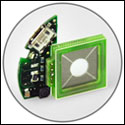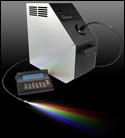by Melinda Rose, senior editor
SAN FRANCISCO, Jan. 26, 2012 — Amplitude Systèmes, PD-LD and 89 North were among the nine Prism Award winners for photonics innovation announced by Photonics Media and SPIE at a gala banquet Wednesday night during Photonics West.
The fourth annual Prism Awards honored 28 finalists in nine categories, with each award category presented by an industry leader. All of the photonic products represented were cited as challenging conventional ideas, solving problems and improving life through the generation and harnessing of light.
“The level of innovation was thrilling and far exceeded our expectations,” said Photonics Media Group Publisher Karen Newman.
The 2011 Prism Award winners for photonics innovation are:
Defense and Security
Physical Optics Corp. (POC)
Mobile ELISA-Based Pathogen Detection (MEPAD)
 The Mobile ELISA is a biohazard detection system with a highly sensitive portable fluorimeter and automated processing for disposable microfluidic chips. It provides responders and point-of-care specialists with a cost-efficient and automated ELISA-based process for field use and identification of concentrations below 100 ng/ml. The fluorescence detection subsystem is composed of a 635-nm diode laser, an avalanche photodiode that measures fluorescence and three filtering mirrors.
The Mobile ELISA is a biohazard detection system with a highly sensitive portable fluorimeter and automated processing for disposable microfluidic chips. It provides responders and point-of-care specialists with a cost-efficient and automated ELISA-based process for field use and identification of concentrations below 100 ng/ml. The fluorescence detection subsystem is composed of a 635-nm diode laser, an avalanche photodiode that measures fluorescence and three filtering mirrors.
Detectors, Sensing, Imaging and Cameras
Mermec
T-Sight 5000
 This system integrates clearance gauge measurement with tunnel wall inspection. Both functions use the same laser illuminating source to inspect and analyze tunnels and clearance profiles on railways, capturing image data of bridges, underpasses, poles, walls, tree branches and other obstacles that may hinder the safe transport of rail passengers and cargo. The system can be mounted to the front of a high-speed train, replacing visual inspections that must be performed slowly and during off-peak traffic hours. The T-Sight 5000 allows real-time inspections at speeds greater than 300 k/h.
This system integrates clearance gauge measurement with tunnel wall inspection. Both functions use the same laser illuminating source to inspect and analyze tunnels and clearance profiles on railways, capturing image data of bridges, underpasses, poles, walls, tree branches and other obstacles that may hinder the safe transport of rail passengers and cargo. The system can be mounted to the front of a high-speed train, replacing visual inspections that must be performed slowly and during off-peak traffic hours. The T-Sight 5000 allows real-time inspections at speeds greater than 300 k/h.
Scientific Lasers
PD-LD Inc.
LabSource VBG-stabilized dual laser source
 This dual-laser source is used in shifted excitation Raman difference spectroscopy (SERDS), the preferred method for the elimination of fluorescence effects in Raman spectroscopy. It allows taking Raman spectra at two very stable and precisely spaced laser wavelengths and replaces more costly tunable lasers for subtracting the fluorescence contribution from the Raman signal. VBG-stabilized laser diodes operate with external feedback from a VBG element. The grating spacing of the VBG determines the wavelength reflected back into the laser cavity and, thus, the emission wavelength of the laser. VBG-stabilized laser diodes have a narrow linewidth and a precisely controlled center wavelength and are considerably smaller, cheaper and simpler to operate than the tunable lasers used previously in SERDS applications.
This dual-laser source is used in shifted excitation Raman difference spectroscopy (SERDS), the preferred method for the elimination of fluorescence effects in Raman spectroscopy. It allows taking Raman spectra at two very stable and precisely spaced laser wavelengths and replaces more costly tunable lasers for subtracting the fluorescence contribution from the Raman signal. VBG-stabilized laser diodes operate with external feedback from a VBG element. The grating spacing of the VBG determines the wavelength reflected back into the laser cavity and, thus, the emission wavelength of the laser. VBG-stabilized laser diodes have a narrow linewidth and a precisely controlled center wavelength and are considerably smaller, cheaper and simpler to operate than the tunable lasers used previously in SERDS applications.
Green Photonics/Sustainable Energy
nanoplus
DFB laser at 3 μm
 These DFB laser diodes perform at the previously unattainable wavelength range between 2.9 and 3.4 μm for tunable diode laser spectroscopy (TDLS) applications, an important technique for gas detection. Reaching that spectral range was made possible in part by the recent commercial availability of application-grade laser sources in that region for sensor applications.
These DFB laser diodes perform at the previously unattainable wavelength range between 2.9 and 3.4 μm for tunable diode laser spectroscopy (TDLS) applications, an important technique for gas detection. Reaching that spectral range was made possible in part by the recent commercial availability of application-grade laser sources in that region for sensor applications.
Industrial Lasers
Amplitude Systèmes
Satsuma HE
 This high-power ultrafast fiber laser combines characteristics that are usually mutually exclusive: a pulse energy greater than 20 μJ, an average power greater than 10 W and an air-cooled housing of less than 13 X 30 in.
This high-power ultrafast fiber laser combines characteristics that are usually mutually exclusive: a pulse energy greater than 20 μJ, an average power greater than 10 W and an air-cooled housing of less than 13 X 30 in.
Other Light Sources
OEwaves
Ultranarrow Linewidth Laser
 This narrow linewidth laser source is based on the self-injection locking of a semiconductor laser diode to a proprietary optical whispering gallery mode (WGM) microresonator and achieves robust supernarrow instantaneous spectral linewidth of less than 300 Hz in a small 14-pin butterfly package. The wide range of optical transparency of the resonator host material allows narrowing the linewidth of a laser at any wavelength, UV to far-IR, making this capability available in wavelength ranges not previously accessible with conventional techniques. These features make the laser suitable for applications in a variety of sensing and communications applications, including harsh environments, as required by many optical-based sensors.
This narrow linewidth laser source is based on the self-injection locking of a semiconductor laser diode to a proprietary optical whispering gallery mode (WGM) microresonator and achieves robust supernarrow instantaneous spectral linewidth of less than 300 Hz in a small 14-pin butterfly package. The wide range of optical transparency of the resonator host material allows narrowing the linewidth of a laser at any wavelength, UV to far-IR, making this capability available in wavelength ranges not previously accessible with conventional techniques. These features make the laser suitable for applications in a variety of sensing and communications applications, including harsh environments, as required by many optical-based sensors.
Optics and Optical Components
Optotune AG
Laser Speckle Reducer
 This product reduces speckle contrast in laser illumination, one of the biggest roadblocks that prevent lasers from becoming the “focus free” standard for projection light sources. Although a traditional approach is to use rotating diffusers, which destroy the temporal and spatial coherence of the laser and smear the speckle pattern, the laser speckle reducer uses electroactive polymers (EAPS, also known as artificial muscles) to oscillate a diffuser, enabling speckle reduction in laser-based pico projectors. The diffuser is mounted on an elastic membrane and moved back and forth using EAPs, resulting in a planar circular oscillation of the diffuser with lateral deflections of 100 to 500 μm at frequencies of several hundred hertz.
This product reduces speckle contrast in laser illumination, one of the biggest roadblocks that prevent lasers from becoming the “focus free” standard for projection light sources. Although a traditional approach is to use rotating diffusers, which destroy the temporal and spatial coherence of the laser and smear the speckle pattern, the laser speckle reducer uses electroactive polymers (EAPS, also known as artificial muscles) to oscillate a diffuser, enabling speckle reduction in laser-based pico projectors. The diffuser is mounted on an elastic membrane and moved back and forth using EAPs, resulting in a planar circular oscillation of the diffuser with lateral deflections of 100 to 500 μm at frequencies of several hundred hertz.
Test, Measurement, Metrology
WITec GmbH
True Surface Microscopy
 True Surface Microscopy is an imaging technique allowing confocal Raman imaging along very inclined or rough samples with the true surface held in constant focus. True Surface Microscopy follows the surface topography with high precision, so that even rough or inclined samples always stay in focus during confocal (Raman) imaging. With this new imaging mode, samples that previously required extensive preparation to obtain a certain surface flatness can now be effortlessly and automatically characterized as they are.
True Surface Microscopy is an imaging technique allowing confocal Raman imaging along very inclined or rough samples with the true surface held in constant focus. True Surface Microscopy follows the surface topography with high precision, so that even rough or inclined samples always stay in focus during confocal (Raman) imaging. With this new imaging mode, samples that previously required extensive preparation to obtain a certain surface flatness can now be effortlessly and automatically characterized as they are.
Life Sciences and Biophotonics
89 North
Heliophor
 The Heliophor is a pumped-phosphor light engine for quantitative fluorescence microscopy, allowing high-speed, live-cell imaging without additional equipment such as shutters and controllers. It provides an alternative to arc lamps, metal halides and LED light sources. Unlike these currently available light sources, the Heliophor’s pumped-phosphor technology allows production of a wider range of output wavelengths, all matched to common fluorescent proteins and dyes. The high-speed switching afforded by the pump source allows the light source to serve as its own shutter, while the internal feedback system maintains ultrastable output power.
The Heliophor is a pumped-phosphor light engine for quantitative fluorescence microscopy, allowing high-speed, live-cell imaging without additional equipment such as shutters and controllers. It provides an alternative to arc lamps, metal halides and LED light sources. Unlike these currently available light sources, the Heliophor’s pumped-phosphor technology allows production of a wider range of output wavelengths, all matched to common fluorescent proteins and dyes. The high-speed switching afforded by the pump source allows the light source to serve as its own shutter, while the internal feedback system maintains ultrastable output power.
Presenting the awards were Tim Day of Daylight Solutions (Scientific Lasers), Mary Lou Jepsen of Pixel Qi (Detectors, Sensing, Imaging and Cameras), Wellington Chadehumbe of Triumph Venture Capital (Defense and Security), Michael Lebby of Translucent (Green Photonics and Sustainable Energy), Laura Smoliar of Peppertree Engineering (Life Sciences and Biophotonics), Robert Huang of Wavelength Technology (Other Light Sources), Michael Cumbo of Idex (Optics and Optical Components), Rob Randelman of Halma (Test, Measurement and Metrology), Larry Marshall (Southern Cross Venture Partners (Industrial Lasers).
Young companies as well as established veterans were among the winners.
“We started in a garage and then moved to a double garage,” Dr. Klaus Weishaupt, managing director of marketing and sales at WITec, said of his company’s humble beginnings, eliciting chuckles from the audience. His company is a spinoff from the University of Ulm in Germany.
Mark Blum, chief operating officer of Optotune, said of his company’s win: “I’m surprised, because we’re a young company, only four years old. It’s a sign that we’re on the right track, and a good sign for laser projection.”
While accepting its award, Physical Optics Corp. pointed out that the company was founded by a husband-and-wife team of Polish immigrants at their kitchen table in 1986.
To watch videos of the winning products, see: www.Photonics.com/PrismAwards
For more information on the nominees, see: 2011 Prism Award Finalists Announced